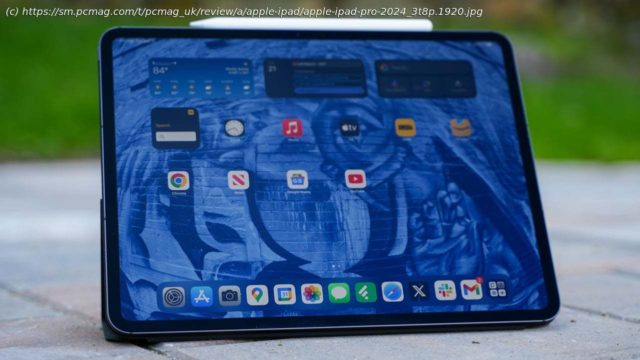Maximum tablet, minimum footprint
The 2024 iPad Pro (starting at $999 for the 11-inch version) is the top of Apple’s refreshed iPad lineup and a higher-end counterpart to the iPad Air (starting at $599). It’s an impressive piece of hardware, with a new OLED display, a next-generation M4 processor, revised cameras, and a fresh selection of accessories. For creators who need the power to render music or video, the iPad Pro easily handles heavy-duty apps like Final Cut Pro, Logic Pro, Photoshop, and more. The latest iPad Air is all most everyday users need in a tablet, but the iPad Pro’s potent performance earns it our Editors’ Choice award for professionals who demand the most.Design: Beyond Thin
Apple has updated half of its iPad lineup with new iPad Pro and iPad Air tablets, both of which are available in 11- and 13-inch versions. The biggest differences between them are the displays and the processors. Apple left the iPad mini ($499) and standard iPad ($349) untouched for now.
The iPad Pro starts at $999 for the 11-inch model and $1,299 for the 13-inch one. Unlike with previous generations, the two Pro tablets share every spec apart from battery size, screen size, and overall dimensions. The 11-inch model measures 9.83 by 6.99 by 0.21 inches (HWD) and weighs 0.98 pounds. The 13-inch model is bigger at 11.09 by 8.48 by 0.20 inches and 1.28 pounds. For comparison, the 13-inch iPad Air (11.04 by 8.46 by 0.24 inches, 1.36 pounds) is nearly identical to the 12.9-inch 2022 iPad Pro (11.04 by 8.46 by 0.25 inches, 1.50 pounds). I tested the 13-inch version.
Non-Apple tablets with similar screen sizes are comparable in size and weight. The 12.9-inch Microsoft Surface Pro 9 (starting at $999) comes in at 11.30 by 8.20 by 0.37 inches and 1.95 pounds, while the 12.4-inch Samsung Galaxy Tab S9+ (starting at $999) measures 11.23 by 7.30 by 0.22 inches and weighs 1.28 pounds.
Many people believe thinner and lighter things are better. In this case, they’re right. The thinner and lighter iPad Pro indeed feels better to use day in and day out. After a week of testing, the iPad Pro’s 0.22-pound reduction in weight (compared with the 2022 model) proved the biggest change in everyday use. It doesn’t seem like a lot, but I found the 13-inch model significantly more comfortable to use when sitting on the couch.
In terms of size, the 11-inch model fits well in small bags and some purses, while the 13-inch model requires something more like a backpack or messenger bag for transport.
The iPad Pro sports an aluminum chassis that forms the flat rear panel and side edges, while an all-glass front nestles into the frame. Apple doesn’t specify what type of glass it uses. It’s an elegant design and manufactured with the highest degree of precision. Apple also doesn’t make any claims about the durability of the tablet. For reference, the Galaxy Tab S9 carries an IP68 rating for protection against dust and water.
Plenty of functional elements line the sides. If you hold the tablet in a landscape orientation, the power button rests at the top of the left side and the volume buttons are nearby on the top edge. All three buttons have excellent travel and feedback. The short sides also host an array of four speakers that produce stereo sound. It’s a pleasure to use the iPad Pro to listen to music or watch movies. The single USB-C (Thunderbolt 3 and USB4) port is on the right edge. Four microphones are scattered about, as well. Apple ditches the physical SIM card tray in favor of eSIM. Three copper pogo pins on the rear provide power and connectivity for accessories.
The rear camera module is in the same spot, but the user-facing camera is now on the top long edge (huzzah!) for an improved video chatting experience. The standard iPad made this change back in 2022, so it was long overdue on the Pro models.
Apple sells the iPad Pro in Silver or Space Black. I received the latter for testing. It’s a darker black than the previous-generation iPad, though I still wish it came in a true deep black. If you prefer brighter colors, opt for the cheaper iPad Air.Display: Just Gorgeous
Apple has relied on LCD technology for iPad displays dating back to the original 2010 tablet. Sure, the 2022 iPad Pro adopted mini-LED, but that’s still a variant of LCD. For 2024, Apple updates both the 11- and 13-inch iPad Pros with OLED technology—and the difference is night and day.
The smaller iPad Pro carries over the screen size from its predecessor but boosts the resolution slightly from 2,388 by 1,668 pixels to 2,420 by 1,668 pixels for the same effective pixel density of 264 pixels per inch (ppi). The larger Pro screen increases in size from 12.9 inches to 13 inches, and from 2,732 by 2,048 pixels to 2,752 by 2,064 pixels (also at 264ppi). Both screens retain an adaptive refresh rate that dynamically changes from 10Hz to 120Hz to balance power needs and performance (Apple calls this ProMotion). Apple boosts the maximum brightness of SDR content from 600 nits to 1,000 nits but keeps the maximum brightness of XDR content at 1,600 nits. However, in keeping with one of the major benefits of OLED technology, contrast doubles from 1,000,000:1 to 2,000,000:1. (Samsung’s Galaxy Tab S tablets have relied on OLED for years, so Apple’s playing a bit of catch-up here.)
To construct these screens, Apple pairs two OLED panels (tandem OLED). This makes for an OLED display that’s twice as bright as a single panel. OLED screens are better at displaying black levels than LCDs, so they look more dynamic overall. Nowhere is the difference more obvious than when you watch HDR content on Apple TV+ or Netflix, edit ProRes footage, or tweak HDR photos. The improved color depth is simply outstanding. Apple says the new screens include P3 color and True Tone for auto-adjusting white balance.
Other standard features apply, including a fingerprint-resistant oleophobic coating, an antireflective coating, and a fully laminated coating. If you care to spend an extra $100, you can upgrade to the nano-texture glass on the 1TB and 2TB models. This micro-etched glass scatters light to create a near-matte appearance with almost no reflections.






